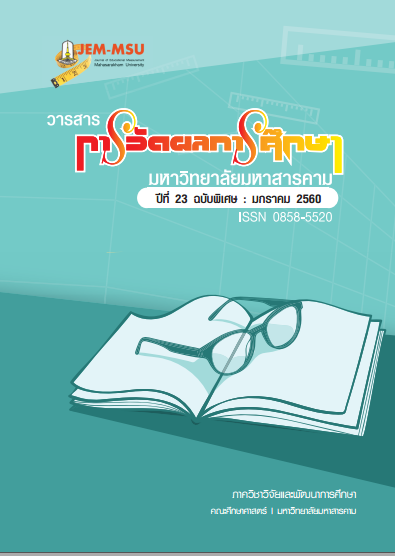The Development an activity learning Resilience Quotient for Strength Of Mathayomsuksa 3 Student : Mixed-Method Methodology
Main Article Content
Abstract
Learning activities, a Resilience Quotient for Strength teacher needs to develop a
good teaching model to promote learner-centered learning since it can help learners learn
continously and resources utility that help create problem-solving process based on
principles, processes, and steps of problem-solving. The present research aimed at studying
fourfold : 1) developing activities, a Resilience Quotient for Strength of Mathayomsuksa 3
Student ; 2) studying the efficiency index of the lesson plans for the developed learning
activities model ; 3) studying the effectiveness index of the lesson plans for the developed
learning activities model ; and 4)comparing the students’ Resilience Quotient before and
after learning using the developed learning activities. The procedure is a mixed-method
research carrying out in 2 steps. The first step was the development of learning activities
model based on related literature and documents from various resources concerning
learning activities model, and interview, then the interview were administered with 5 master
teachers for the development of the learning activities model, and syntheses of ProblemBascd Learning activities process for the development of Problem- Bascd Learning plans
learning activities. The second step was the pilot of the developed plans learning activities.
learning activities model which was piloted with the Target group who were 20 Matthayomsueksa
3 students studying in a class at Nonkasangvittayacom School. The research instruments
used for data collection were interview were administered with master teachers, learning
activities plans, and a measure of Resilience Quotient Rating Scale, which comprised 5
aspects. Data were divided into 2 parts for analyses: the data obtained from the interview
were administered with 5 master teachers; and the data obtained from the pilot of the
teaching model. The statistics used for data analyses were mean, standard deviation, and
percentage. The Wilcoxon Signed Rank Test was used for testing hypothesis.
The results were as follows :
1. The developed learning activities model, including principle, objective,
content, learning process, assessment, and learning activity model conceptualised by Joyce
and Weil consisted of 4 steps. The 1st step was the teaching procedure (syntax) which
included presentation to encourage students to get ready before studying, learning activities
management, and the 5P problem-solving learning encouragement: problem issues survey,
seeking techniques for problem-solving, problem-solving solution, problem-solving results
presentation, problem-solving assessment, and evaluation of activities participation and
testing. The 2nd step was the teacher-student interaction (social system) that the teacher
guides and advises students to think for problem-solving. The 3rd step was the principle of
reaction that the teacher teaches by using the instructional media to encourage and
promote good relationship between teacher and students. The 4th step was using concrete
teaching aid or media to encourage the students to learn.
2. The efficiency value (E1/E2) of the developed learning activities plans
Resilience Quotient for Strength of Problem-Bascd Learning and the students’ learning
achievement was 76.38/80.94, which was higher than the assigned criterion of 70/70.
3. The effectiveness index (E.I.) of the students’ was 0.5688 mean scores Of
Mathayomsuksa 3 Student with Resilience Quotient after activity increased 56.88 percent.
4. The students’ mean scores of Resilience Quotient and learning of ProblemBascd Learning activities achievement after learning by using the developed was higher than
before learning at the .05 level of significance.
In conclusion, The Development an activity learning Resilience Quotient for
Strength is efficient, effective, and appropriate for activity learning Resilience Quotient for
Strength. The students are Resilience Quotient for at a high level. Consequentlya teacher
can apply this learning activities model for Resilience Quotient and learning of ProblemBascd Learning activities in order to serve the purposes.
Article Details
The content and information contained in the published article in the Journal of Educational Measurement Mahasarakham University represent the opinions and responsibilities of the authors directly. The editorial board of the journal is not necessarily in agreement with or responsible for any of the content.
The articles, data, content, images, etc. that have been published in the Journal of Educational Measurement Mahasarakham University are copyrighted by the journal. If any individual or organization wishes to reproduce or perform any actions involving the entirety or any part of the content, they must obtain written permission from the Journal of Educational Measurement Mahasarakham University.


